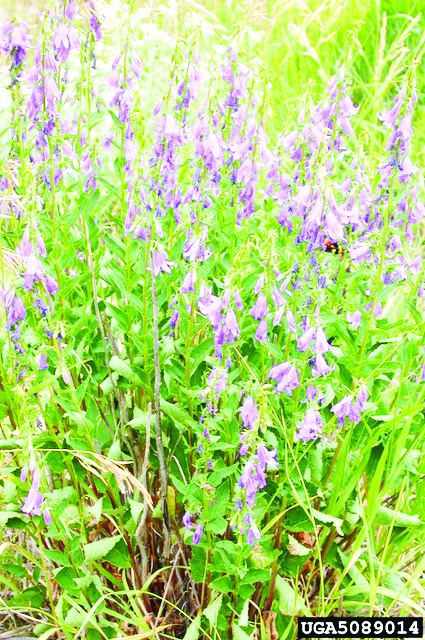Article by Monika Smith
Time to talk, again, about the creeping purple bellflower (Campanula rapunculoides).
This is an ‘uber’ weed! If you miss those couple of leaves emerging from the ground in spring, you will be dealing with it as a mature plant when it will be really dug in by that point.
The purple creeping bellflower takes over, bullying its way across lawns and into flower beds. The next thing you know, there’s a sea of purple. That’s a thug.
It’s native to Siberia and Eurasia and was brought over to North America by some of the first European settlers, becoming widely naturalized in North America. To our dismay. This plant made it to Calgary as a worthy garden flower over a century ago. In those days, not a lot of thought went into gathering plants and seeds from one part of the world and growing them in another, especially if it behaved there and of course had some value: aesthetic, exotic, industrial, food. Such a horrifically misguided idea. So many introduced plants have just become a scourge.
Today, the creeping bellflower is found throughout Glendale in garden beds, along property lines and marching throughout the back alleys. It is a perennial, grows quickly in sun and deep shade, and it has lovely clusters of spikes up to one metre long with gorgeous purple bells. The early emerging leaves look like a pretty, delicate ground cover with attractive heart shaped leaves that change to the typical lance-shaped, tooth edged, and coarse leafed spike. It doesn’t need weeding or watering and is disease resistant.
Governments across Canada and the USA have it listed as very invasive. If you have some, get rid of it. That means lots of digging and sifting often to 30 cm or more of soil to remove most lateral roots and taproots. Our heavy clay soil does hinder it somewhat. But nice loose loam? It just gallops. I’ve had that moment of triumph and despair digging up a thumb-sized root, as a piece. These tuberous rhizomes are what keeps the plant going even during drought.
Keep the plant striped of leaves, cut to the ground, digging out the roots. It will succumb eventually, in spite of its nuclear war shelter of root below. Don’t compost. Bag it and place in your black cart! Desperation means chemicals, but this remarkable plant is resistant to some, and, for a home yard, the chemicals can do more harm than good.
There’s plenty of literature online about this plant. Check out the City of Calgary and creeping bellflower and Alberta’s Invasive Species Council fact sheet.
If you’re interested in showing your garden to a friendly group of plant lovers, who want to learn and exchange knowledge, tell us about successes and get some shoulders to sob on? Contact me! Been there and done that.
Until next time,
from Monika’s Grove

The infernal root of a purple creeping bellflower. Nicely, and totally dug up at Mike and Jenn Meredith’s place. A win! Photo courtesy of Jenn Meredith.

Purple creeping bellflower, be afraid, very afraid, if this is what you have or have seen. Photo courtesy of Mary Ellen (Mel) Harte, Bugwood.org.
Click here to the Glendale Community News home page for the latest Glendale community updates.










